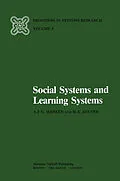In today's social and behavioral sciences, the complexity of many problems requires the development of a number of highly specialized disciplines. However, the cost of such development is the obscuring of the relationships between these disciplines. This dilemma calls for a "mixed strategy" that combines the advantages of specialization with those of a unified viewpoint. The purpose of this book is to provide the connective tissue that is needed to obtain an overall view. The principles of general system theory naturally lead to a framework that includes many known models and content areas; our intention is to strike a balance between generality and plain usefulness. The first part of this book introduces a social system as a network of inter acting decision makers. This general framework allows a classification of a num ber of more specific structures, which include autocratic and democratic systems, systems with collective and individual decision making, and systems with and without coalitions. In the second part, various psychological schools are seen as specific instances of a general paradigm, which is consequently a point of departure for a taxon omy of learning systems. For a full understanding of this matter, we recommend a careful study of the first four chapters as an introduction to the concepts elaborated in the second part of the book. ix PREFACE x Though the subject matter has a formal background, it does not require a mathematical knowledge in depth; familiarity with elementary probability theory and linear algebra is enough.
Inhalt
I Social Systems.- 1 System Theory: A Survey.- 1.1. Introduction.- 1.2. Mathematical System Theory.- 1.3. Systems Engineering.- 1.4. Organismic System Theory.- 1.5. The Model Loop.- 1.6. Applications.- 2 System Cell and Classification.- 2.1. Introduction.- 2.2. The System Cell.- 2.3. A System Classification.- 3 The Concept of an Objective.- 3.1. Definition.- 3.2. Preferences and Values.- 3.3. Stochastic Goals.- 3.4. Goal Vectors.- 3.5. Goal Trajectories.- 4 Paradigm of a Social System.- 4.1. Introduction.- 4.2. Paradigm and Decision Cell: Decision Phase.- 4.3. Paradigm and Decision Cell: Realization Phase.- 4.4. Adaptation, Ideal, and Aspiration Level.- 4.5. Rationalization.- 4.6. The Instrumental Decision Maker.- 4.7. Forrester's Method.- 5 Models of Social Systems.- 5.1. Introduction and Classification Criteria.- 5.2. Networks of System and Decision Cells.- 5.3. System Science and Organization Science.- 6 Collective Systems without Communication.- 6.1. Introduction.- 6.2. Arrow's Dilemma.- 6.3. Majority Rule and Copeland's Rule.- 6.4. Restrictions on Individual Preferences.- 6.5. Decisions Based on Metric Scales.- 6.6. Conclusion.- 7 Collective Systems with Communication.- 7.1. Introduction.- 7.2. A Linear Model.- 7.3. Simple Coalitions Based on Values.- 7.4. Conclusion.- 8 Autonomous Two-Person Systems without Communication.- 8.1. Introduction.- 8.2. Two-Person Constant-Sum Games.- 8.3. Two-Person Games without Constant Sum.- 8.4. Conclusion.- 9 Autonomous n-Person Systems and Dynamic Games.- 9.1. Autonomous n-Person Games.- 9.2. Dynamic Games.- 10 Two-Person Cooperative Games.- 10.1. Introduction.- 10.2. Static Models: Game Theory.- 10.3. The Bargaining Process.- 10.4. Conclusion.- 11 Cooperative Games with n Persons.- 11.1. Games without Coalition Formation.- 11.2. A Few Game-Theoretical Concepts.- 11.3. Coalitions.- 11.4. The Shapley Value.- 11.5. Simple Coalitions Based on the Number of Votes.- 11.6. Conclusion.- 12 Hierarchical Systems.- 12.1. Introduction.- 12.2. Examples of the Interaction-Balance Principle.- 12.3. Coordination and Iteration.- 12.4. Conclusion.- 13 Conclusions.- 13.1. Recapitulation.- 13.2. Hybrid Systems.- 13.3. Epilogue.- Problems, Part I.- II Learning Systems.- 14 Learning Systems.- 14.1. Introduction.- 14.2. Learning Primary Systems.- 14.3. Learning Instrumental Systems.- 14.4. Learning Normative Systems.- 14.5. Skinner's Learning Theory in the Context of System Theory.- 14.6. Degeneration of the Basic Elements of a Learning System.- 15 Taxonomy of Learning Systems.- 15.1. Basic Configurations.- 15.2. Taxonomy of the Basic Configurations.- 15.3. Learning Paradigms.- 15.4. Degenerations of the Learning Paradigms.- 16 Applications.- 16.1. Pattern Recognition or Pattern Classification as a Learning System.- 16.2. Adaptive Pattern Recognition.- 16.3. Model Learning with the Potential Function Method.- 16.4. Model Adaptation with the Potential Function Method.- 16.5. Model Adaptation with Amalgamation.- 16.6. Adaptive Estimation of a Density Function with the Potential Function Method.- 16.7. Adaptive Bayesian Estimation of a Density Function.- 16.8. Stimulus Sampling Theory.- 16.9. Marketing Management.- 16.10. Linear Model for Probability Learning.- 16.11. Learning of Social Behavior by Reinforcement.- 16.12. Linear Learning Model of Buying Behavior.- 16.13. Learning Inventory System.- 16.14. Closing Remark.- Problems, Part II.- References, Part I.- References, Part II.- Index, PartI.- Index, Part II.
